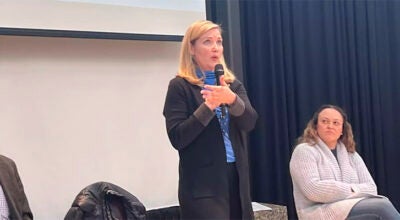Citizens hear both sides with ‘Immigration 101’
Published 7:16 am Friday, March 19, 2010
Citizens on both sides of the immigration debate attended a workshop on the topic last night, but the purpose of the meeting was to set opinions aside and learn about the current immigration system.
“In order for people to have good discussion and really dig into reform, we need to understand what it is that we’re looking to reform,” said Kirsten Lindbloom, one of the events organizers and a Canadian immigrant to the U.S.
About 35 people attended “Immigration 101” at Riverland Community College Thursday night. The session was designed to be an educational session to provide basic background about the hotly debated issue of immigration.
Madeline Lohman, a program associate with the Advocates for Human Rights, presented on the current U.S. immigration process.
Many people hold deeply seeded values to one side of the immigration debate, and Lohman said it’s important for people to have all the facts and be educated about the current process.
“People have very different ideas of how they want the country to look, and we think part of the public process is to work that out as long as it respects certain basic human rights, Lohman said.
After the health care debate and the issues with Toyota, Lindbloom said immigration reform may be the next issue on the horizon.
The meeting, which was sponsored by the Austin Human Rights Commission, the Advocates for Human Rights and APEX Austin, was meant to be neutral of stances on immigration reform. Instead, the meeting focused on informing people about the current system.
Austin attorney Dan Donnelly attended the meeting and answered questions on immigration law, which he described as a complex area.
While Donnelly said he is “immersed in the battle,” he said he tries to stay out of the politics of the immigration debate. Instead, he said he tries to follow the law, and educate citizens about immigration laws.
“I think it’s important for me to explain to people what the law is and how it affects the people who do live here in Austin,” he said.
Paths of immigration
In order to immigrate to the U.S., people need to have a close relative living in the U.S., or they need to be skilled in a certain field.
“Immigration is not easy,” Lohman said. “It’s an extremely complicated process.”
Not only is immigration complex, it’s often expensive.
According to Lohman, the complexities of the immigration process and few visas for low-skilled workers may be reasons for illegal immigration.
Before the recession, an estimate 12 million illegal immigrants lived in the U.S., but that’s dropped to 10.8 million Lohman said.
However, Lohman said most illegal immigrants would prefer to be here legally, but would have to wait for a long time to immigrate.
“For many people, there’s no way in,” she said. “If you don’t have a family member here, if you’re not skilled, if you don’t have a lot of money, you have very few opportunities for coming to this country.”
While immigration is rarely easy, people with close family members who are citizens or permanent residents in the U.S. have a pathway to immigrate.
People with a parent, spouse or a minor child have one of the easiest methods to immigrate and become a legal citizen. However, the process still likely takes six or more years.
People who are the sibling or the adult child of a citizen can apply to come to the U.S., but the wait time depends on the person’s home country and can be anywhere from 12 to almost 30 years.
If a potential immigrant is the spouse or child of a lawful permanent resident, he or she has a good chance of becoming a citizen, but again, there is a long wait.
Another way to immigrate is for on a work visa, but this can be a difficult process that is often dependent on an employer, Lohman said.
People considered experts or have rare skills have potentially the quickest route to a green card and potential citizenship.
However, low-skilled workers have the fewest opportunities to immigrate. Lohman presented data from studies that say there’s a very low number — about 5,000 — of visas for low-skilled workers, and such visas have to translate to permanent residency. The demand for those visas was about 500,000 people before the recession, Lohman said.
Refugees and asylum seekers can come to the U.S., but such immigrants need to provide proof of the imminent harm or persecution that forced them to leave.
Effects of immigration
Some studies show immigrants have a positive impact on the community. Lohman said immigrants are said to increase the national gross domestic product by $37 million each year. And, immigrants tend to put in $20,000 to $80,000 more to taxes and benefits than they use. Other studies show today’s immigrants learn English at the same rate as immigrants in the past, Lohman said.
However, some in the audience criticized the statistics, saying they’ve seen contradictory statistics, though they didn’t offer any alternate numbers during the meeting.
While it’s difficult to know how many immigrants and illegal aliens are living in Mower County, representatives with Austin Public Schools said the percentage of non-white students in the schools has doubled in the last decade to about 30 percent. One school building even broke the 50 percent mark.
Lindbloom, who first came to the U.S. on a student visa and then stayed in the country on a work visa, said it took nearly eight years to get a green card. By the time she’s a citizen, she expects total fees — lawyer fees, travel costs and waved fees — will total about $30,000.
Lindbloom expressed her personal beliefs, as she said she supports legal immigration, but she sympathizes with people going through the process with little hope and long waits.
“I’m educated, white and I speak English, and the system was challenging,” she said. “It was unfriendly. And it’s just agonizing as far as time and the unknowns.”
At the same time, she said it’s difficult for people to gain citizenship if they don’t meet the criteria, and she hopes there could someday be more avenues for such people to take to become legal citizens.
“I think the barriers are just so great,” she said.
To learn more about the current U.S. immigration process, go to www.energyofanation.org.
Mower County Immigration
— 5 percent of Mower County residents are foreign born
— 25 percent increase in the number of foreign born people living in the county since 2000.
–18.5 percent of students in Austin Public Schools speak another language at home.
Statistics from the American Community Survey.





